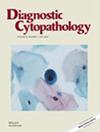Diagnostic Utility of Clusterin in Fine Needle Aspiration Biopsy and Core Biopsies of Hepatocellular Carcinoma
Abstract
Background
Several immunohistochemical markers are available for demonstrating hepatocytic differentiation, thereby confirming the diagnosis of hepatocellular carcinoma (HCC). Clusterin is a new marker of malignant hepatocytes, not evaluated in fine needle aspiration biopsy (FNAB) samples. Hence, we evaluated its diagnostic utility in FNAB cell blocks (CB) and core biopsy samples.
Methods
A total of 47 cases of HCC diagnosed on FNAB with CB (41)/core biopsy (6) were retrieved. For comparison, CB from metastatic adenocarcinoma (15) and cases with incidental benign hepatocytes (12) were included. Immunohistochemistry (IHC) for clusterin was performed and the 3 groups were compared to derive its sensitivity and specificity. Canalicular expression was considered positive for hepatocytic differentiation.
Results
The cohort comprised 47 cases of HCC, with 43 (91.5%) male and 4 (8.5%) female patients with an age range of 20–78 years. On clusterin IHC, benign hepatocytes showed a track-like canalicular pattern whereas in HCC, typical enhanced canalicular positivity (3+ intensity) was seen in 32/47 (68%) cases, 17 of which additionally showed cytoplasmic positivity. Only cytoplasmic positivity was noted in 7 HCC cases and was considered negative. All cases of well differentiated (6/6), 67.6% (25/37) of moderately differentiated, and 25% (1/4) of poorly differentiated HCC showed enhanced canalicular positivity, whereas metastatic adenocarcinoma showed cytoplasmic (2/15) or nucleocytoplasmic (1/15) positivity only.
Conclusion
IHC for clusterin with enhanced canalicular pattern of expression revealed 68% sensitivity and 100% specificity for HCC, aiding its distinction from metastatic adenocarcinoma and benign hepatocytes in FNAB samples, thereby confirming its diagnostic utility.

 求助内容:
求助内容: 应助结果提醒方式:
应助结果提醒方式:


